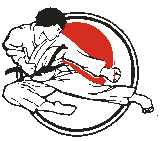 |
| Re (nay) is a bowing done formally from a kneeling position, or informally from a standing position. The purpose of the formal bow is to achieve physical and mental tranquility. Sempai (sempie) are sen i6r Black Belts. At the end of the class the command Sempai-Ni-Rei means bow to the senior members. |
 |
 |
| All ABOUT BOWING |
| Midwest Karate |
| ITKF/JKA |
| You are also expected to bow, to show respect; in the following situations: 1. when entering or leaving the dojo, towards the flags; signifying mutual respect toward the founding country of karate; and our own country, jointly. 2. before and after each class, to the instructor, to show respect for his ability and knowledge. 3. before and after Kumite (koomee~tay) or sparring practise, expressing mutual respect, trust and appreciation to each other. 4. before and after Kata practice, to show respect for the masters who developed the art of Karate-do. Bowing in (at the beginning of a class) Formal class procedures for opening and closing the class are announced by the highest ranking belt. ? Mokuso (mu kso) means to close the eyes to meditate or contemplate quietly, and thus separate the karate training. from the outside world. The problems and worries of our daily lives are to be left behind, and full attention given to the study of Karate. When done at the end of class, think about the lesson given and feel you have done your best. ? Yame (yamay), means open your eyes. ? 5homen-Ni~reiI (showmen-neeray) means bow to the front. ? Sensei-Ni~eiI (sen say-neeray) means bow to the instructor.- Chief Instructor is Sensei Jerry Marr . ? Sempai (sempie) are sen i6r Black Belts. At the end of the class the command Sempai-Ni-Rei means bow to the senior members. ? Sempai (sempie) are sen i6r Black Belts. At the end of the class the command Sempai-Ni-Rei means bow to the senior members. |